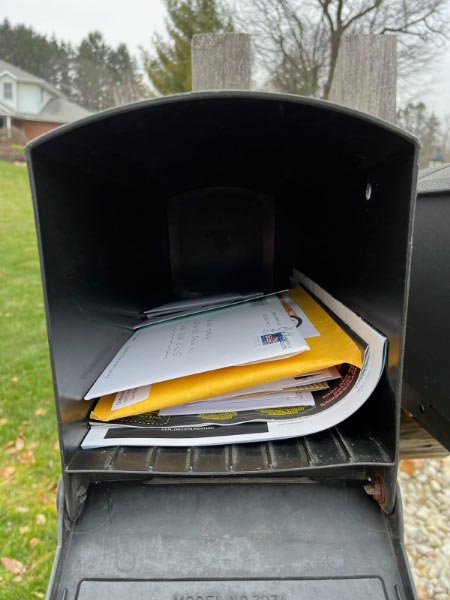
One fine Thursday evening in early December I retrieved the day’s mail, not on my phone or my desktop, but from my real mailbox, on a post at the end of my driveway.
It would be the last time I would do so for five days. Oh, I checked every day, but no mail was delivered. It wasn’t just me; my neighbors didn’t get any either. Finally, on Tuesday, we had not one, but two separate deliveries of massive piles of mail.
It was a curious way for our local post office to celebrate the eight-month anniversary of the enactment of the Postal Service Reform Act, which affirmed that by law the U.S. Postal Service must deliver mail six days per week.
“Apparently they can’t find mail carriers to hire,” said Jeff Castle, our local township trustee, after he spoke with our postmaster.
Yet, our home state has one of the highest unemployment rates in the nation.
The main entrance to our business is locked on Saturday, but we have a mail slot as required by postal regulations. A couple years ago our Saturday mail delivery became erratic until it tapered off to maybe once every month or two.
Do they or don’t they? Even the mail carrier doesn’t seem to know for sure.
Want to complain? The U.S. Postal Service's communication system makes it almost impossible for the average postal patron to contact their local post office by phone or email.
“I’ve sent messages to my local post office a few times when deliveries seem amiss and have received prompt and polite responses,” said Cindy Walas.
Ah, but Walas is seasoned print communication professional with a thorough knowledge of things postal. The average consumer has neither the time nor the inclination to break through the communication walls that the USPS seem to have intentionally constructed.
Rod Lowe, whose direct mail expertise far exceeds mine, lays blame at the feet of the current postmaster. Perhaps, but I must observe that these problems have been decades in the making, which brings me to my point.
Every time I write about postal woes I strike a chord, receiving spirited responses from printers, mailers and even postal carriers. The experts weigh in, but expertise is a two-edged sword. I suggest we all need to step into the shoes of the average postal recipient who is frustrated and puzzled by postal unreliability, and who is increasing offered alternatives to mail that are lower in cost, easier to use, and in their perception, more reliable.
My neighbors don’t give a hoot about presorting or co-mailing, but they are certainly annoyed when the mail arrives after sunset, or not at all. They perceive that Amazon’s own trucks deliver packages same day (even on Sunday.) However, if the same package is shipped by USPS it takes longer, and arrival is much less predictable.
The trades people and manufacturers in my industrial park may use direct mail marketing, but they are frustrated when checks are lost in the mail, which happens much too frequently.
We all become indigent when a vendor tells us to “go green” or “save trees” by “going paperless.” Lately I’ve noticed a trend: savvy firms are instead touting safety, security, convenience and reliability as reasons to switch to paperless communications. These will be harder to rebut.
As for me, I’m doing my part to promote print. The USPS needs to do theirs.










Discussion
Join the discussion Sign In or Become a Member, doing so is simple and free